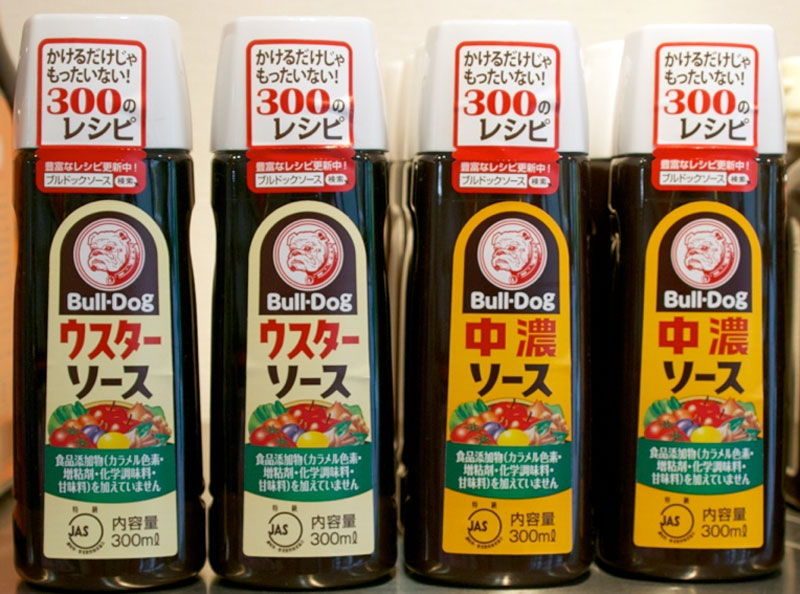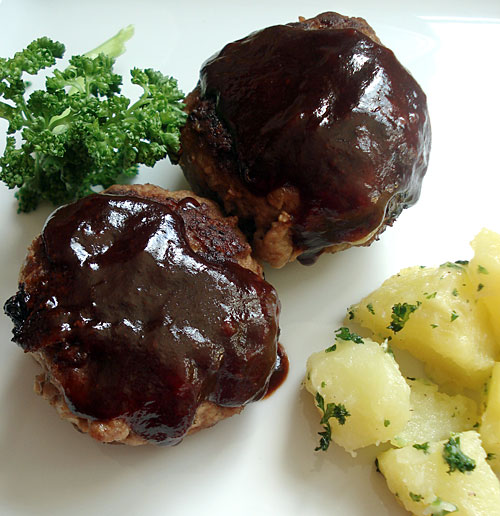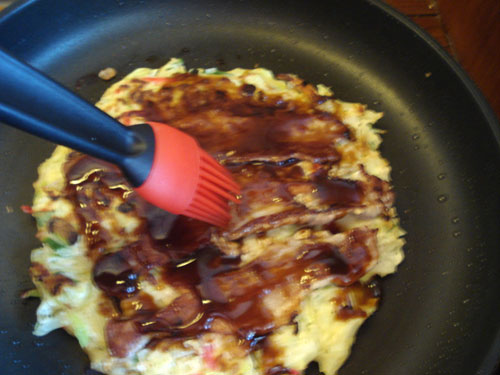The Mystery of Japanese "Sauce"

Miso, soy sauce, bonito flakes...these are the kinds of ingredients you'd expect to be used in Japanese recipes. But there's another ingredient that appears very often, and it's usually just called "sauce" or so-su (ソース). What is this "sauce" anyway?
This is the most popular brand of Japanese "sauce", although there are several other makers. It features a picture of a Bulldog. Some people call all "sauce" Bull-Dog sauce.

On the English version of the Cookpad site, it was decided early on to call it "Japanese Worcestershire-style sauce". It does indeed taste like that classic English sauce made with mystery ingredients including anchovies, but it's a lot thicker, sweeter, browner. "Sauce" appears on all kinds of foods, from Japanese hamburgers (which are more like 'hamburger steaks' rather than American burgers)...

...to okonomiyaki...

...and a lot more. Besides being used as, well, a sauce, it's also used to add flavor to stews and soups, in marinades, and a lot more.
So what is this "sauce" anyway? While there are variations, called tonkatsu sauce (used on tonkatsu or breaded deep fried pork cutlets); chuunou sauce (pictured above) which just means 'medium-thick' sauce, usta- sauce, which is the Japanified version of Worcestershire (but usta- sauce is nothing like original Worcestershire sauce); okonomiyaki sauce, and so on. There's little difference between them though, except in the degree of sweetness, and a slight difference in fruitiness and viscosity. Most "sauces" list "vegetables, fruit and spices" as their ingredients, plus amino acids (umami), sweeteners, caramel coloring and other things depending on the type.
"Sauce" apparently made its debut in the late 19th century in Japan, when it was sold as a different kind of soy sauce. This didn't work out well, since it tasted so different from well, real soy sauce. "Sauce" really only took off in the post-World War II era, along with the rapid growth in popularity of westernized or yohshoku (yoshoku) cooking, which had previously been limited to the big cities.
While it's still associated with yoshoku, as its use on things like okonomiyaki and takoyaki shows it's now used as a flavoring ingredient for all kinds of cooking. For example the Japanese version of stir fried noodles, yakisoba, is flavored with "sauce", unlike the Chinese version (lo mein) which is flavored with a soy sauce base.
So do you need "sauce" in your Japanese cooking pantry?
Well..it all depends on how much it costs for you. If you live near a Japanese, Korean or general-Asian grocery store, and it's fairly inexpensive, then by all means have a bottle around. You can use any brand you like, although Bull-Dog brand is quite reliable. (Bull-Dog sauce apparently used to be called "Inu-jirushi So-su", which means "Dog Brand Sauce". I think the name change was a good idea...)
"Sauce" can be used for things other than Japanese food - on all kinds of meaty or deep fried dishes, in stir fries, and so on.
As I mentioned above, I don't think there's a big enough difference between the "sauce" types to require stocking up on all of them, unless you want to of course or can spare the cash and space. Okonomiyaki sauce is sweeter and thinner than chuuno sauce for example, but there's not a big difference. See below for ideas for doctoring any kind of "sauce". For what it's worth, right now I have one bottle of chuuno sauce in my fridge.
Reasonable substitutes for "sauce"
If you don't have a Japanese/Asian grocery store near you, you can substitute other brown sauces. Traditional British Worcestershire sauce (such as the one from Lea and Perrins) is a great sauce and flavoring ingredient to have around anyway, but it's not really a good substitute for Japanese "sauce".
For that purpose I have at various times used A-1 Steak Sauce in the U.S., and HP Sauce in Europe. (Here in France, the latter is sold in our local supermarché in the "ethnic" food section.)
Both are a lot tangier than Japanese "sauce" though, so you need to temper it a bit. Adding sugar works, but molasses or golden syrup may work better. You can try adding some grated apple (a sweet variety, not a sour cooking variety) too. For okonomiyaki, you may need to add sugar or other sweetener in a 1:2 ratio of sweetener to sauce to come close to commercial okonomiyaku sauce. Or, if you like your okonomiyaki with mayonnaise too, add a bit more mayo to neutralize the sauce's tanginess. Of course if you like tangy sauce anyway, you can just use one of those sauces straight.
I have seen a few recipes suggesting oyster sauce as a "sauce" substitute, but to me the flavor profile is quite different, so I recommend one of those sauces mentioned above instead.
[By the way, I'm boosting up my 'Japanese ingredients explained' section. If you need a Japanese ingredient explained in detail, and you can't find an explaination here yet, just let me know and I'll see what I can do.]



 Welcome to Just Hungry, where we serve authentic Japanese recipes and more! I'm
Welcome to Just Hungry, where we serve authentic Japanese recipes and more! I'm 














Comments
Peter H. Coffin
7 October, 2013 - 18:07
Permalink
Re: The Mystery of Japanese "Sauce"
Lea & Perrins makes a thick version of their Worchestershire sauce that's not quite as tangy as A-1 that may make another good option.
torontoviewer
7 October, 2013 - 18:15
Permalink
Re: The Mystery of Japanese "Sauce"
This is useful to know. THanks!
theyams
7 October, 2013 - 18:36
Permalink
Re: The Mystery of Japanese "Sauce"
Thanks for the explanation. I live near many Japanese markets and am always amazed at the variety of "sauces" there and was wondering if I was missing out on anything.
Maye
7 October, 2013 - 18:44
Permalink
Re: The Mystery of Japanese "Sauce"
Hello, Makiko-san, I'm happy to see you blogging!
I've seen on cookbooks they mix for tonkatsu sauce
ketchup, dashi, a bit of mustard, worcestershire sauce and a bit of soy sauce. Can it be accurate?
I love your site, it's been a great inspiration and thanks for sharing the news about the english Cookpad site! I'm totally addicted!
Vaut Le Voyage
7 October, 2013 - 18:52
Permalink
Re: The Mystery of Japanese "Sauce"
Is there a way to find out if the sauce is made with MSG?
I have stopped choosing Tonkatsu because of the use in the sauce of MSG or a similar product I have an allergy to.
Your blogs are where I turn to first and usually don't have to go further.
Thanks for all you do for us English speakers!
maki
7 October, 2013 - 19:00
Permalink
Re: The Mystery of Japanese "Sauce"
Unfortunately, just about all commercial tonkatsu sauce and similar "sauce" has MSG in it, unless you can get a 'natural, no additives' brand...which is pretty hard outside of Japan. If you are allergic you'd need to stay away from them I'm afraid (you may need to watch non-Japanese sauces too).
EI
7 October, 2013 - 22:05
Permalink
Re: The Mystery of Japanese "Sauce"
I just use the regular Worcestershire sauce because in my area, the Japanese bull dogs cost about 15$ for a tiny freaking bottle.
Yummie
8 October, 2013 - 02:56
Permalink
Re: The Mystery of Japanese "Sauce"
Swirl this "sauce" with Kewpie Mayonaise - very authentic sauce of Japanese childhood. Yum!
Best to dress this dressing with shredded cabbage - a very common side salad in Japanese meals.
anon.
8 October, 2013 - 15:17
Permalink
Re: The Mystery of Japanese "Sauce"
i'm sooo glad you wrote this, maki. hope you're feeling better! i just bought bulldog sauce today too. hehe yes good thing they changed the name from the literal japanese translation, eh? ;)
Bee
8 October, 2013 - 16:03
Permalink
Re: The Mystery of Japanese "Sauce"
This article was really useful thanks! I just have one question:
Is there a difference between Unagi Sauce and Tonkatsu Sauce?
Deb
8 October, 2013 - 17:58
Permalink
Re: The Mystery of Japanese "Sauce"
While we were travelling across the globe Bulldog tonkatsu sauce was hard to get occasionally - a mix of 50% ketchup and 50% brown sauce/HP sauce did the job most of the time. It's not the same but it maintains the thickness and fruity flavour.
Charlie Sommers
8 October, 2013 - 18:45
Permalink
Re: The Mystery of Japanese "Sauce"
Luckily my neighborhood (Nashville, Tn.) abounds with Asian Markets and Bulldog Sauce is easy to come by. I have given it to friends for Christmas a few times along with bags of panko and instructions on how to make tonkatsu. I have received many thanks for both the recipe and the sauce. Everyone loved it.
I don't worry about MSG. I have a shaker of it on my table right now and use it like I do salt and pepper and have been doing this for over 50 years. It occurs naturally in so many things like, seaweed, tomatoes, celery, etc. The glutamate in MSG is chemically indistinguishable from glutamate present in food proteins. Our bodies ultimately metabolize both sources of glutamate in the same way. An average adult consumes approximately 13 grams of glutamate each day from the protein in food. Although many people identify themselves as sensitive to MSG, in studies with such individuals given MSG or a placebo, scientists have not been able to consistently trigger reactions. In most people the supposed allergy seems to be mostly psychosomatic.
anon.
8 October, 2013 - 19:19
Permalink
Re: The Mystery of Japanese "Sauce"
I found a recipe for tonkatsu/okonomiyaki in my favourite Japanese cookbook, The Japanese Kitchen by Hiroko Shimbo, and would gladly share it here, if you'd like. ^_^ It is so easy to make and of course you can play around and adjust it to your personal taste.
As for Bull Dog sauce, I use it in all sorts of ways, from scrambled eggs to last night's successful experiment: tacos! mmmmm... it is great stuff!
BTW...I simply cannot figure out how to get registered for Just Hungry. When I hit the link, it tells me I don't have access to that page. >_<#
anon.
8 October, 2013 - 19:44
Permalink
Re: The Mystery of Japanese "Sauce"
when i want a sauce like this, e.g. for okonimyaki, i usually just mix worcestershire sauce, ketchup and soy sauce. probably too simplistic and only a very rough approximation, but it's easy and easy to remember.
Gigi
9 October, 2013 - 04:42
Permalink
Re: The Mystery of Japanese "Sauce"
Is Bulldog inexpensive to get in Japan?
Tom
9 October, 2013 - 05:30
Permalink
Re: The Mystery of Japanese "Sauce"
I'm a fan of Hiroko Shimbo's recipe for tonkatsu sauce; though I've taken to reducing the sugar by half, and using Lea and Perrin's thick Worcestershire sauce (now renamed "BOLD steak sauce").
If you don't have thick Worcestershire available, I would suggest adding corn starch to thicken. Can take a while to reduce to the right consistency otherwise, and your whole house will smell of it for much longer. Sauce is good, but I don't like my cake to be perfumed with it.
http://www.cookstr.com/recipes/tonkatsu-sauce
Angel
9 October, 2013 - 10:06
Permalink
Re: The Mystery of Japanese "Sauce"
Thanks Maki! I learn so much from you! =)
Anon
9 October, 2013 - 17:51
Permalink
Re: The Mystery of Japanese "Sauce"
Yum!
Speaking of substitutes for Bulldog sauce, this website reckons that Bulldog sauce is "similar to our own (British) HP sauce, but with an even thicker texture":
http://www.finefoodspecialist.co.uk/bulldog-tonkatsu-sauce-300ml/
As does this website:
http://www.theherald.com.au/story/1542363/five-of-a-kind-japanese-sauces/
HP is thicker than Worcestershire sauce, so perhaps it would be a better substitute texture-wise than Worcestershire sauce.
Sylvia S. B. S.
9 October, 2013 - 19:51
Permalink
Re: The Mystery of Japanese "Sauce"
Much to my surprise, yesterday I found Bull Dog at my local Raley's supermarket in Nevada! Raley's carries a good selection of "ethnic" foods, including Asian condiments, etc. Though I didn't expect to, I was delighted to find it! As you said, the taste is unique, perhaps reminiscent of other sauces and flavorings, but quite distinct. Very tasty. Thank you for including a photo; otherwise I would have missed it -- right in front of my eyes on the shelf!!!
jesslin
10 October, 2013 - 17:16
Permalink
Re: The Mystery of Japanese "Sauce"
Actually, I've wondered about "sauce" for a while. We have a thriving Asian population around Chicago, so it shouldn't be hard to find (Mitsuwa's Japanese grocery isn't far away from me), but I like knowing the approximations too. I'm not very experimental with making food, so your descriptions of what the taste is like will be very helpful in trying to attain similar flavors when I do cook. Your blog is really helpful, thanks!
Annva
11 October, 2013 - 14:26
Permalink
Re: The Mystery of Japanese "Sauce"
I'll see if I can find it in my asian grocery, I think I never saw it but hey, it's worth to check.
I hope you are feeling better, take care and rest a lot!
The Elf
11 October, 2013 - 15:02
Permalink
Re: The Mystery of Japanese "Sauce"
This stuff is great! I picked some up the other day to try to make okonomiyaki (did a so-so job on it). It is tasty stuff! I think I like it better than Worcestershire. It's sweeter, without being too sweet.
The Elf
16 October, 2013 - 15:16
Permalink
Re: The Mystery of Japanese "Sauce"
Just for kicks I put some on my scrambled eggs this morning. Nice touch! This might become a new favorite.
Make-Believe Castle
11 October, 2013 - 18:14
Permalink
Re: The Mystery of Japanese "Sauce"
I have some Bull Dog Tonkatsu Sauce. I bought it to serve with okonomiyaki and I like it. But I once made a similar sauce with equal parts of ketchup, agave syrup and vegan Worcestershire sauce and it was good too.
Claire (@kurea_san)
12 October, 2013 - 13:35
Permalink
Re: The Mystery of Japanese "Sauce"
Ahhhh - the classic Japanese brown sauce. When I left Japan one of my work work mates gave me a bottle as a going away present... rather amusing at the time.
Claire xx
http://somewhereyonder.blogspot.co.uk/
Silvia
1 November, 2013 - 18:28
Permalink
Re: The Mystery of Japanese "Sauce"
Please explain about black sesame paste, and how to make fillings for buns, mooncakes and other sweets out of it.
I love your site, you explain everything so well.
cromm
4 November, 2013 - 17:25
Permalink
Re: The Mystery of Japanese "Sauce"
thanks for the post.
I would like to know how to make a decent copy of the Japanese sauce. I experimented with some ingredients and the result was ok but not universally acclaimed by my home taster.
Wombat
5 December, 2013 - 02:01
Permalink
The Mystery of Japanese "Sauce"
No real mystery here.
You can make a tolerable Bulldog sauce by mixing up Worcestershire, tomato sauce (catsup) a dash of vinegar and a big smear of American style mustard.
When our son was still a toddler, sitting at eye-level with the sauces and condiments on our table, he innocently asked for some "inu no shoyu", which translates out to "Doggie Soy Sauce" and that's what we've called it ever since.
Musashi Foods
15 March, 2014 - 15:54
Permalink
Re: The Mystery of Japanese "Sauce"
Another great Japanese "sauce" is Japanese Spicy Mayo. It's a great accompaniment for sushi and fantastic addition to burgers and other sandwiches. Give it a try!
jun
27 March, 2014 - 17:03
Permalink
Re: The Mystery of Japanese "Sauce"
Hi
hello could you please give me the recipe for making tolerable Bulldog sauce , am in vietnam so hard to fine thise kind of sauce , am not really a cook but my job right is a cafeteria cook i do my best to cook could you please help me on that recipe . thank you very much in advance..